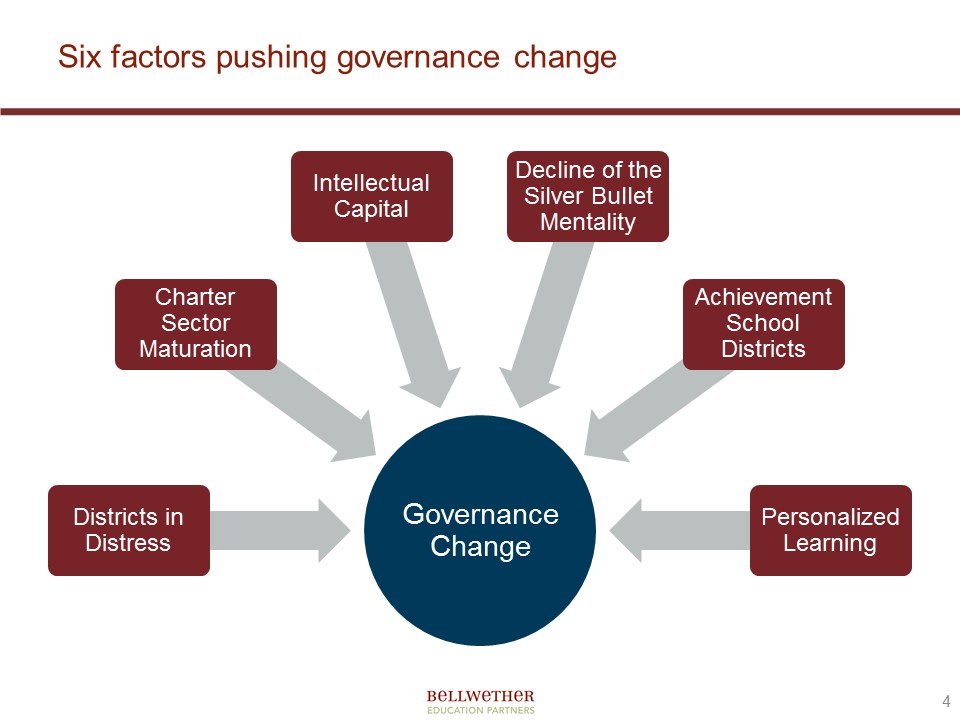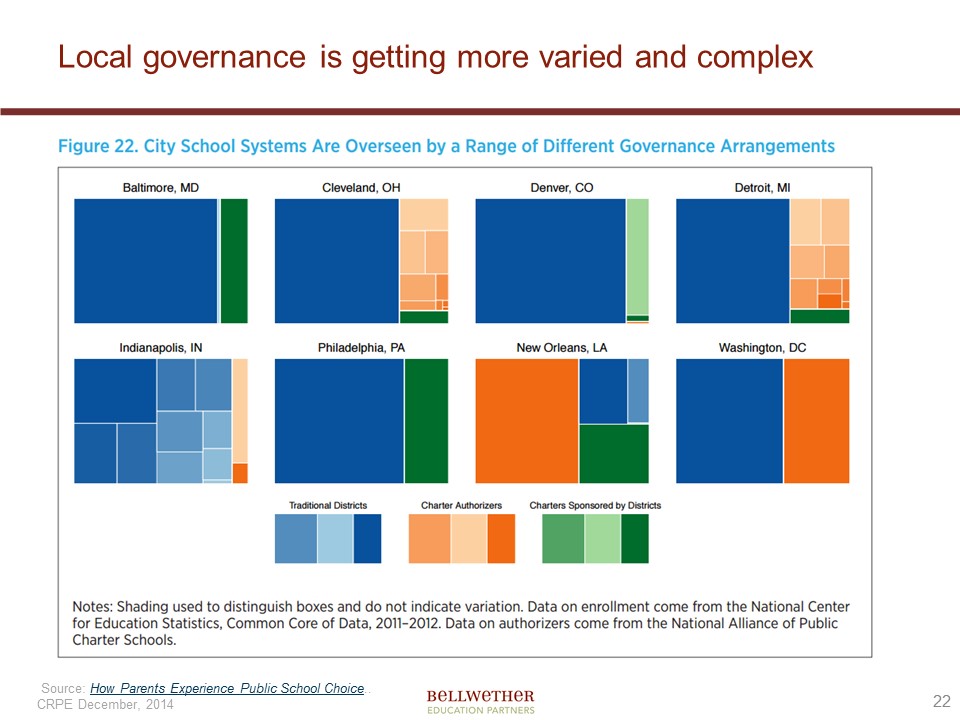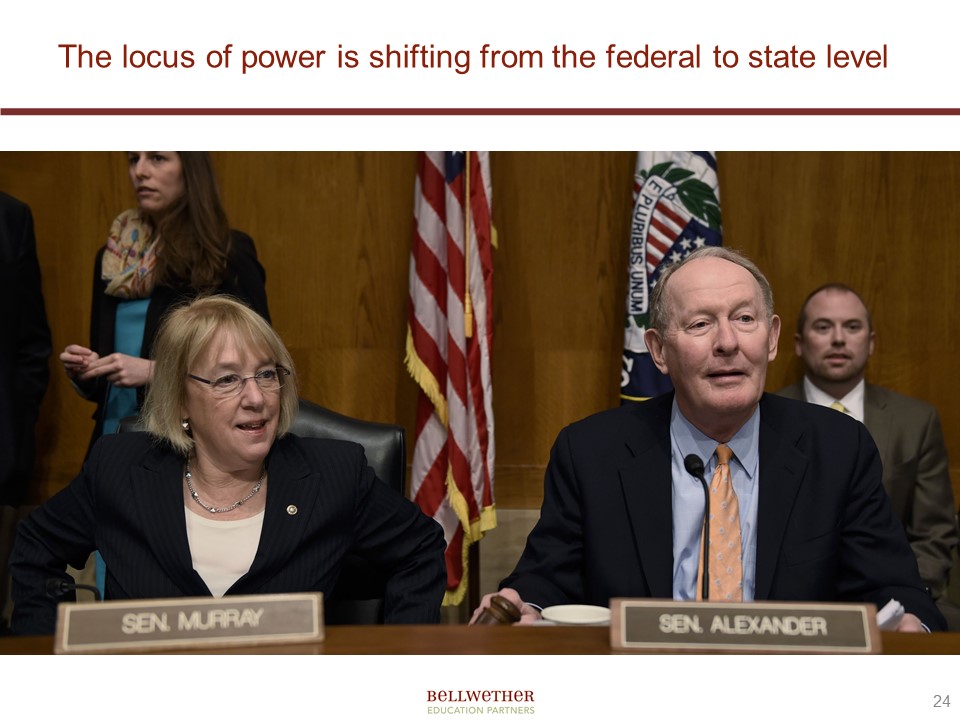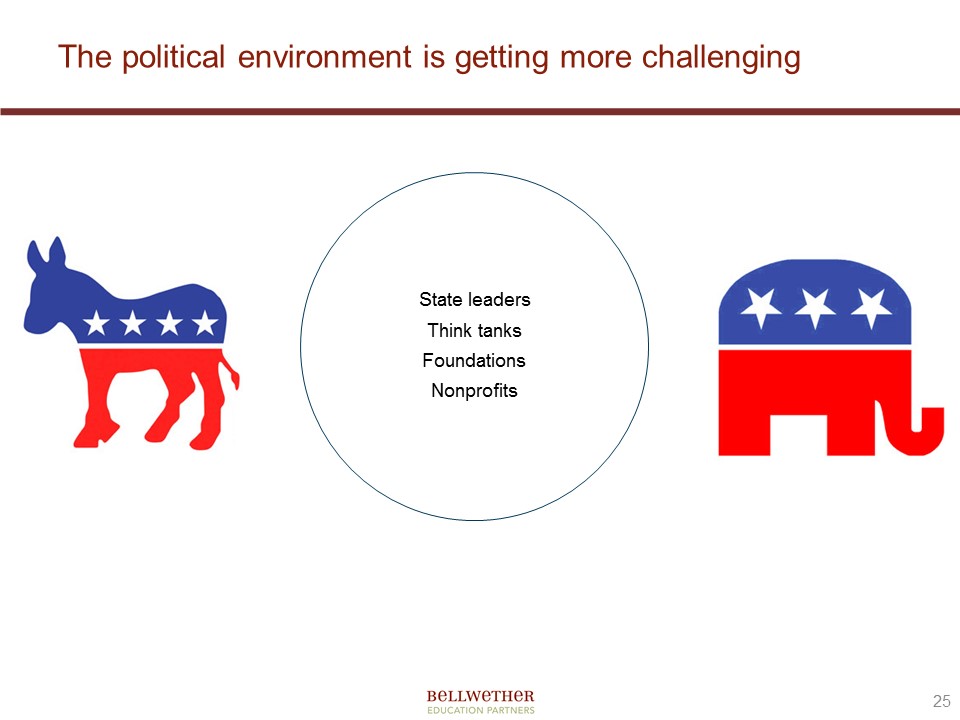Earlier this month, Bellwether, together with the Donnell-Kay and Gates Family Foundations convened a small group of thought leaders and practitioners from across the country to discuss the latest theories in governance and learn from the cities that are implementing innovative governance models.
I kicked off the meeting with a presentation on the state of education governance in the US. To level set and to keep us focused on the summit’s topic, I started with a definition of governance from the Institute for Governance and the Council of Europe’s 12 principles for good governance at the local level. Guiding principles like these remind me that governance is a part of democracy that’s designed and redesigned to suit a society’s changing needs rather than a permanent fixture to be left alone.
For the rest of my presentation, I described six major forces that are pushing governance to the forefront of the national education reform conversation as well as the likely future impact of ESSA and the polarizing political landscape. Here are a few of the most illustrative slides from that presentation.

1) Districts in Distress

Many urban school districts experience academic and financial distress. Academic distress is born out clearly in the latest TUDA results that show stark achievement gaps between white and black students and little improvement in the last twelve years. On the financial side, each state has a different method of defining and monitoring financial distress, but they all point to a similar trend – many urban districts have struggled to stay solvent. State receivership is often the result and bankruptcy looms as a drastic measure. Outsized financial pressures in big city school districts often serve as a window of opportunity for leaders to explore the option of a new governance model, but financial distress should never be cheered, encouraged, or seen as brush clearing. Insolvency has incredible destabilizing effects that go far beyond a school district and into entire communities.
2) Charter Sector Maturation
Earlier this year, my Bellwether colleagues produced a remarkable tome on the state of the charter school movement. What you’ll see there is the growing number of charter schools, their increasing quality, and host of equity questions that come from increased market shares in cities around the country.

Compared to all other factors, the latter may be the one pushing the governance question to the forefront. Charters used to be exceptions that accounted for a few schools in a city. However, as market shares start to breach the 20% mark, they start to evolve from being a part of the system to the system itself. When a city hits 40-50%, charters have the responsibility to take up equity issues on a citywide scale in ways that they might not have had to in the past. Making discipline, special education, transportation, and back-filling work in a decentralized system requires a different type of governance thinking. Much of the retrospective on Louisiana’s Recovery School District centered on such issues. Also notable is the rise of independent, non-district authorizers, which created an entirely new governance model outside of districts that are driven by the accountability sandwich of parental choice and state oversight.
3) Intellectual Capital
For decades, ideas and dialogue about alternative governance models has been considered radical and fringy compared to other reform strategies like talent, curriculum, charters, and personalized learning. Paul Hill, David Osborne, Ted Kolderie, my Bellwether colleague Andy Smarick, and others have been derided as extremists, but a growing stock of intellectual capital around governance coupled with bold action on the ground has legitimized the governance conversation. New books are being written and the old books are being dusted off and considered ahead of their time. Social media has made governance conversations public, which has helped to refine ideas, align allies, and create a wider following.
4) Decline of Silver Bullet Mentality
I’m guilty of silver bullet thinking. I spent most of my career focused on recruiting system level leaders thinking that if we just saturated a district, CMO, or state agency with whip smart people, all the problems would go away. After spending years doing this and listening to all those bright people hit bureaucratic barriers, legal walls, or special interest groups, I began to think more about the system we were sending them into. Talent isn’t the only silver bullet. There’s school size, class size, curriculum, professional development, teacher evaluations, technology, accountability, wraparound services, and mayoral control to name a few. Make no mistake, all of these pieces are still needed, but placing them within a dynamic system of schools rather than a rigid bureaucracy gives them the best chance of fulfilling their true potential.
5) Achievement School Districts

Achievement School Districts (or Recovery School Districts or Opportunity School Districts) have changed the way that states intervene in the worst performing schools. Although ASD’s prioritize more dramatic interventions like closures and restarts over reconstitution, the true innovation is entirely new governance models that have performance contracts at their hearts. By my count, 16 states have pursued ASD legislation since 2004. Interestingly, if you look closely at the bills, you’ll see variations on the original laws in Louisiana and Tennessee. In the best light, this can be seen as innovation. More likely, it’s the forces of politics molding the ASD idea to fit local contours. The recent uptick in ASD bill introduction is a trend I see accelerating with the help of an ESSA provision (Sec. 1003) that allows states to set aside up to 7% of their Title I allocation for an ASD, 5% of which could go to administration of the system.
6) Personalized Learning

Technology is enabling new school models, which, in turn, challenge the policies, and structures that govern them. Unlike the other factors, this one is largely bottom-up. Currently, the personalized movement has not his sufficient scale to challenge most policies. Waiver and workarounds are the norm for policy barriers.
The Results of These Six Forces

If you look around the country, you no longer see cities where public schools are run by districts and a few private and charter schools in its orbit. Instead, you see that local governance is getting more varied and complex. Independent authorizers, charters, vouchers, and state school districts are creating much of this complexity but it also shows a willingness to upend conventional wisdom.
In the next decade, we’ll see two kinds of urban school systems. The first will be in cities that plan for this complexity, harness the best performing operators, and mitigate equity issues that arise in decentralized systems (e.g. DC). The second will be in cities where markets get ahead of regulation coordinating bodies to create chaos (e.g. Detroit). The graphic in the slide is from CRPE’s 2014 report, How Parents Experience Public School Choice.
Looking Forward: ESSA and Politics

The recent passage of ESSA gives states far more latitude on how to intervene in the lowest performing schools. Block grants and the Title I carve out provide the space for novel funding solutions. In the best case, ESSA opens up lots of possibility for new approaches. Unfortunately, history suggests states will pursue regressive policies and practices that hurt poor, black, and Latino students the most. (Sidenote: I’m with Andy Rotherham and Chad Aldeman’s analysis.)

The two national political parties, which once met in the middle on charters and choice under the Bush II and Obama administrations, are moving apart again. Democrats drifting toward the unions (Ahem, Hilary) and republicans toward pure market solutions. For the most part, state leaders, philanthropy, and think tanks (even many partisan ones) remain in the middle as they seek pragmatic and actionable solutions. For those interested in governance change as a solution to chronically failing systems, solutions will either have to be deftly pitched so everyone can win or be willing to enter the dog-eat-dog world to get things done.
Thanks to Paul Hill, Ashley Jochim, Joe Siedlecki, Neerav Kingsland, Andy Smarick, and Julie Squire for their input on this presentation.